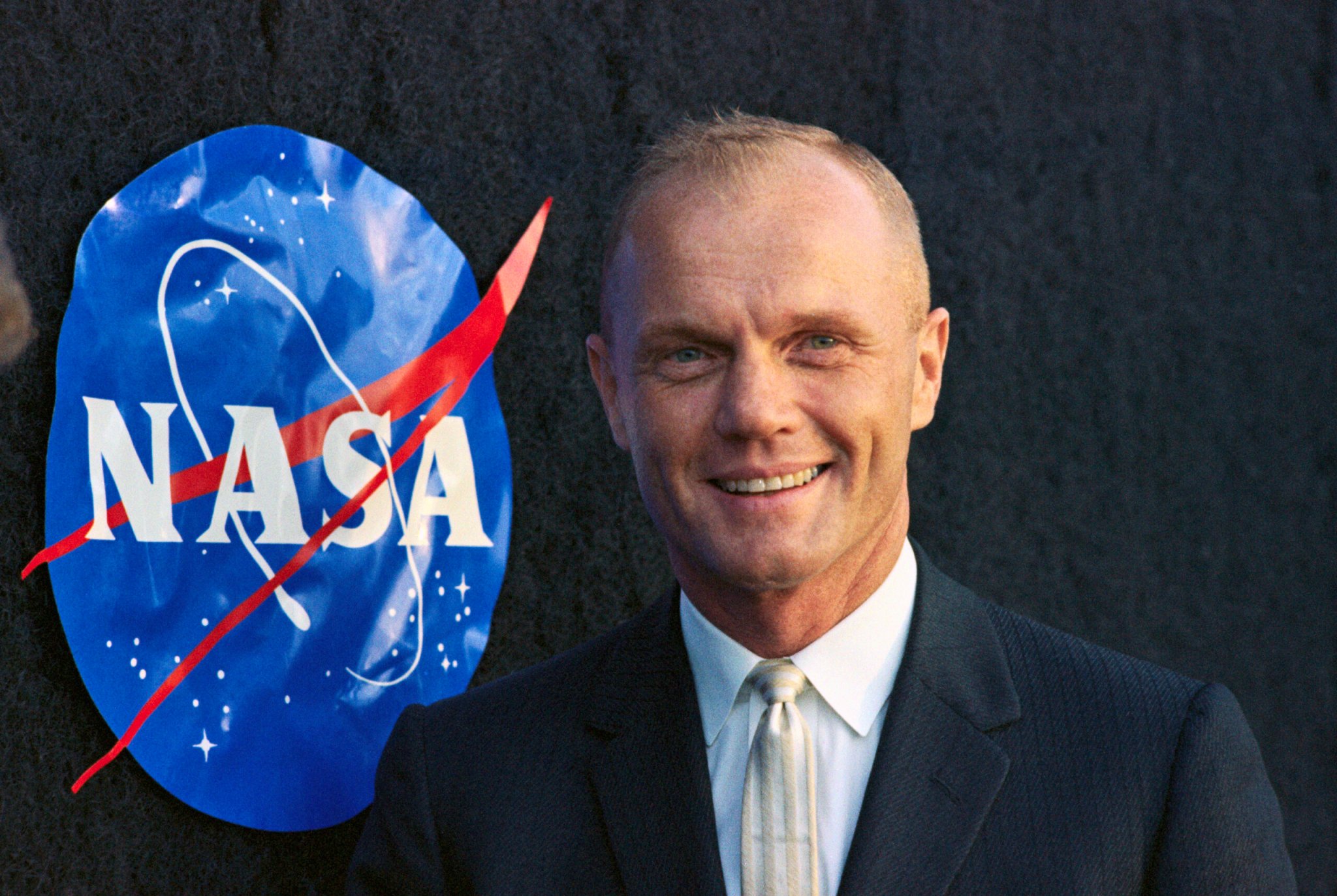

John Herchel Glenn was born in July 18, 1921 in Cambridge, Ohio to John Sr. and Clara Teresa Glenn. His father, a Great War veteran, took John on his first aircraft ride when he was only 8 years old. To hear him tell it, that ride influenced the rest of the younger John’s life. He built models, read books, and was enthralled with anything related to aviation, earning his private pilot’s license at 20 years old through the Civilian Pilot Training Program. Glenn entered Muskingum College but dropped out shortly after joining when World War Two broke out and he chose to enlist as a US Navy aviation cadet. By March 1943 he had completed flight training, transferred to the Marine Corps, commissioned as a 2nd Lieutenant, and married his hometown sweetheart Annie before being sent overseas to the Pacific Theater.
While initially being assigned to fly R4D transport aircraft, he applied and was accepted to the VMF-155 fighter squadron flying F-4U Corsairs, eventually completing 57 combat missions while being promoted to captain shortly before the end of the war. While most of the men in uniform returned home to their civilian lives, Glenn stayed in the Air Corps, accepting a regular commission and volunteering again for overseas duty, seeing combat in northeastern China supporting Operation Beleaguer, the mission to evacuate foreign nationals out of increasingly hostile Chinese Communist territory.
Glenn was reassigned to the US and promoted to Major in 1952. Soon after he again received combat orders, this time to South Korea where the war had been raging for over two years. Before leaving, he applied as an exchange officer to the US Air Force, learning to fly the F-86 Sabre. While he waited for the paperwork for his transfer to be processed Glenn served as an ops officer in VMF-311, earning the name ‘Magnet Ass’ over the course of his 63 missions due to the amount of flak damage he’d accumulate when flying close-air support. Ted Williams was also one of his squadron-mates.
After Glenn was finally transferred to the USAF 25th Fighter Squadron he shot down 3 MiG-15’s in just 10 days, less than a week before the war officially ended. With no wars left to fight, he applied and was accepted to the US Naval Test Pilot School, graduating in July 1954. From there he was heavily involved in the testing of new airframes and weapons, to include the FJ-3 Fury, F-8U Crusader, and F-7U Cutlass.
Despite being stuck with a desk job at the Fighter Design Branch of the Navy Bureau of Aeronautics, Glenn still found ways to fly, even managing to complete the first supersonic transcontinental flight on July 16, 1957. His world-record flight took just 3 hrs and 23 minutes, which Glenn pulled off by pitching the trip as a way for the Navy to demonstrate the capabilities of the F-8U.
By the ripe old age of 36 Glenn had already logged almost 9,000 flight hours, and when a test pilot was requested for assignment at the new National Aeronautics and Space Administration (NASA), he jumped at the chance. Already being one of the few American pilots with extensive high-G experience flying jets, Glenn became the subject matter expert on the topic, and worked heavily with NASA to assist in the design of their new spacecraft.
Glenn’s combat experience, peerless flight record, and dedication to the evolution of human spaceflight made him a natural fit for the role, and he was eventually chosen along with 6 others over hundreds of qualified candidates to join the Mercury program as an astronaut. Countless months of training passed, and Glenn’s relentless focus on the mission culminated with his launch in the Friendship 7, becoming the first American in orbit, and a living legend.

Unfortunately, the toll of his career was wearing him down physically, and soon Glenn found himself the oldest member of the active astronaut corps. Realizing his age would likely disqualify him for the Apollo moon missions, Glenn was instead convinced to run for Congress, campaigning in 1964, 1970, and winning in 1974, a seat that he would hold until 1999. He even ran for President briefly in 1984 before dropping out.
Sadly for America, and despite a storied political career spanning almost three decades, even a hero like John Glenn couldn’t handle American politics forever, and he resigned in 1999. For most of us that would be the end of an incredible, almost unbelievable life of public service to the military and the nation, but Glenn wasn’t done. While senator he had lobbied NASA for some time to send an elderly astronaut into space, arguing that the effects experienced by astronauts (bone density loss, plasma degradation, etc) are the same as those of the natural aging process. NASA agreed, and unsurprisingly the senator had the perfect candidate in mind for the mission.
On Oct. 29, 1998 John Glenn strapped into a spacesuit for the last time and left earth as a member of the STS-95 shuttle mission, becoming the oldest person to fly in space at 77 years young.
Despite his military, political, and astronautical careers being over, Glenn continued flying, maintaining a private license until he was over 90 years old. When John finally passed away on Dec 8, 2016 he was surrounded by his loving wife, children, and grandchildren.
Learn more about legends like John Glenn on What Made America Great, Untold:Patriots Revealed, and other great shows highlighting the best our country has to offer on Fox Nation, the streaming service that focuses on programming that celebrates America, her people, stories, and history.
Subscriptions are currently available for their entire programming line-up absolutely free for one year to active military, veterans, and law enforcement personnel.
For more great programming options check them out here.
This article was sponsored by Fox Nation.
